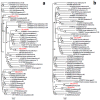Revealing enterovirus infection in chronic human disorders: An integrated diagnostic approach
- PMID: 28694527
- PMCID: PMC5504018
- DOI: 10.1038/s41598-017-04993-y
Revealing enterovirus infection in chronic human disorders: An integrated diagnostic approach
Abstract
Enteroviruses (EVs) causing persisting infection are characterized by minimal replication and genetic changes. Typing of these agents may complement disease assessment and shed light on pathogenesis. Here we report an integrated approach for EV detection in human samples that is based on pre-enrichment of virus in cell culture before search for the viral genome and viral antigens. Cases of post-polio syndrome, type 1 diabetes, and chronic cardiomyopathy were investigated. As tissue-based approaches require invasive procedures, information was mainly gleaned from virus in blood. Molecular assays targeting conserved genome regions of all EV types (5'UTR, 2 C, 3Dpol) were employed. As compared to direct assays of plasma or leukocytes, the EV detection rate was significantly enhanced by co-culture of leukocytes with cell lines prior to molecular and immunologic tests. Results of RT-PCR and sequencing were confirmed by staining cell cultures with a panel of EV-specific antibodies. Sequence and phylogenetic analysis showed that EVs of the C species (polioviruses) were associated with the post-polio syndrome, while members of the B species were found in type 1 diabetes and cardiomyopathy. The procedure may be used for investigating the possible association of different EVs with a variety of chronic neurologic, endocrine, and cardiac disorders.
Conflict of interest statement
The authors declare that they have no competing interests.
Figures





References
-
- Pallansch, M. A., Oberste, M. S. & Whitton, J. L. In Fields Virology Vol. 2 (ed. Knipe, D. M. & Howley, P. M. & Fields, B. N.) 490–530 (Wolters Kluwer Health/Lippincott Williams & Wilkins, 2013).
-
- Asturias EJ, et al. Humoral and intestinal immunity induced by new schedules of bivalent oral poliovirus vaccine and one or two doses of inactivated poliovirus vaccine in Latin American infants: an open-label randomised controlled trial. Lancet. 2016;388:158–169. doi: 10.1016/S0140-6736(16)00703-0. - DOI - PubMed
Publication types
MeSH terms
Substances
LinkOut - more resources
Full Text Sources
Other Literature Sources
Medical
Research Materials

